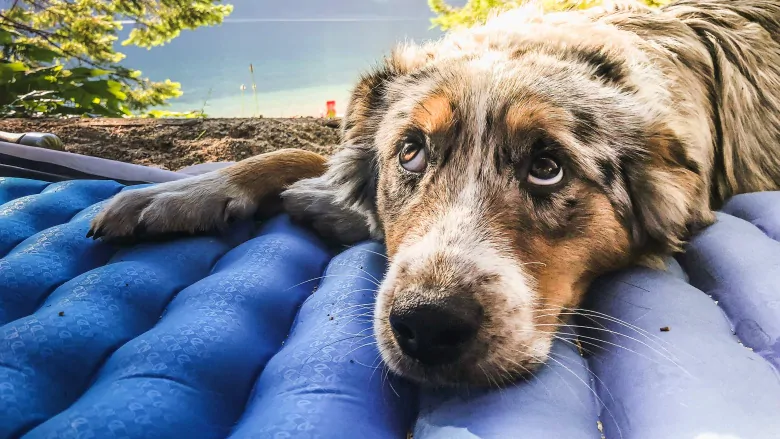Australian Shepherd was killed by lawfully set trap
Most people asked about their new puppy begin with a sweet story. Louis Seguin begins his differently:
"We were the unlucky ones," he said Thursday.
Seguin and his partner were out with their dogs — Shasta and Chinook — for an afternoon walk near their home in Winlaw, B.C., on Friday when Shasta ran off the forest service road.
The couple heard a "scream" and thought the 10-month-old puppy had been attacked by a cougar. She'd actually been caught in a trap, lawfully set on Crown land about six metres from the trail.
Shasta died in her owners' arms.
"We tried to get her out, but we didn't know what we were doing," Seguin said. "It was too hard."
The couple is now lobbying the province to tighten rules around where traps can be set in B.C., but trappers say prevention is less about mandated rules and more about proper education.
Trap was legal: conservation service
Shasta, an Australian Shepherd, was killed by a Conibear trap — a steel, body-gripping trap designed to kill animals quickly.
Officers with the B.C. Conservation Service (BCOS) investigated Shasta's death and found the trap had been lawfully set.
The only mandated restriction on traps in B.C. is that they can't be within 200 metres of a residence. Conibears are only banned from municipal land.
Since Shasta died, Seguin and the FurBearers — a non-profit committed to preventing trapping cruelty — have launched a petition called for stricter rules for trappers.
Seguin would like to see the 200-metre rule expanded, but they're mainly calling on the province to bring in a mandatory trap signage system. Under that, trappers would have to post "bright, visible signage" to alert people when there are traps within 20 metres of a place where people and pets could be walking.
"So, it's clear to the neighborhood that there's traps and then they know: don't walk your dogs — instead of the other way around where you find out because your dog's dead," Seguin said.
The dog owner, who still has Chinook, said he's also watched videos to learn how to free a dog from a Conibear since Shasta died.
"Just in case," he said.
Trappers' side of the debate
Pete Wise, who's been trapping for 60 years, said too much signage leads to lawful traps being interfered with or stolen — valuable furs and all.
"I've seen it happen," he said. "The guys that are out there trapping, [they're] trying to make a living."
Wise has also been teaching courses on proper, humane trapping practices in B.C. and the Yukon for nearly 25 years. He said, ideally, traps are set 100 metres back in the bush.
"There's a lot more to just putting the trap on the ground," Wise said. "You have to look at ... the consequences and the moral consequences of what we're doing."
He continued: "We do not want to catch people's pets."
The debate between trappers and pet owners can be volatile, and conservation officers often run into the fray first-hand when they respond to calls like Seguin's.
Sgt. Ben Beetlestone said telling a dog owner their pet was killed by a legal trap is a tough conversation to have.
"You just try to be emotional with the dog owner, at the same time ensuring that they understand the activity that took place was was totally allowed," said the officer, who has 18 years' experience.
The BCOS receives around eight reports of pets being caught in traps every year. A statement from the B.C. Forests Ministry said it's currently working with the B.C. Trappers Association on a program to produce warning signs that could be used by trappers in active trapping areas, if they choose.

